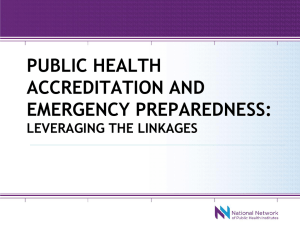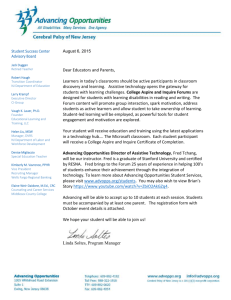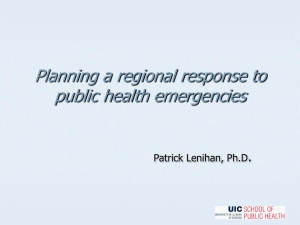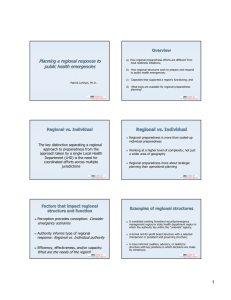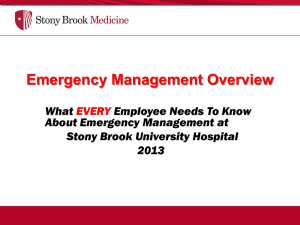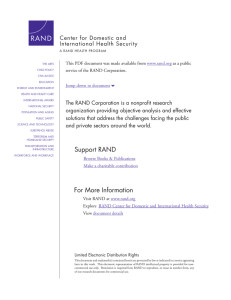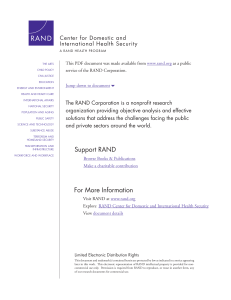6 Center for Domestic and International Health Security om
advertisement
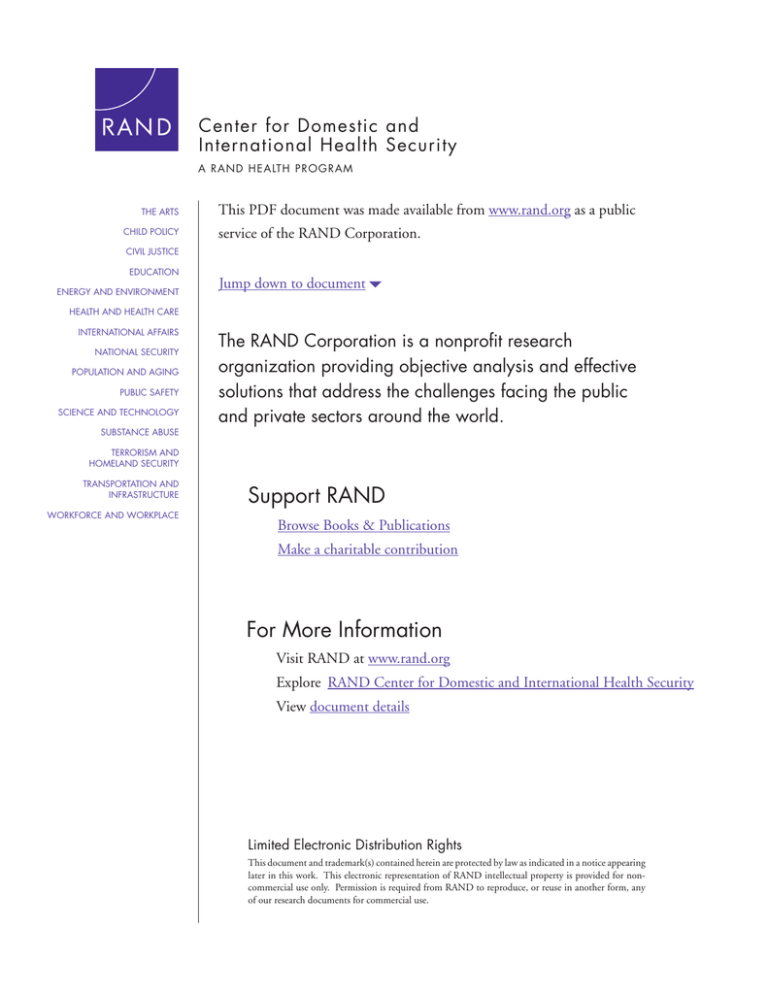
Center for Domestic and International Health Security A R A N D H E A LT H P R O GRAM THE ARTS CHILD POLICY This PDF document was made available from www.rand.org as a public service of the RAND Corporation. CIVIL JUSTICE EDUCATION ENERGY AND ENVIRONMENT Jump down to document6 HEALTH AND HEALTH CARE INTERNATIONAL AFFAIRS NATIONAL SECURITY POPULATION AND AGING PUBLIC SAFETY SCIENCE AND TECHNOLOGY SUBSTANCE ABUSE The RAND Corporation is a nonprofit research organization providing objective analysis and effective solutions that address the challenges facing the public and private sectors around the world. TERRORISM AND HOMELAND SECURITY TRANSPORTATION AND INFRASTRUCTURE WORKFORCE AND WORKPLACE Support RAND Browse Books & Publications Make a charitable contribution For More Information Visit RAND at www.rand.org Explore RAND Center for Domestic and International Health Security View document details Limited Electronic Distribution Rights This document and trademark(s) contained herein are protected by law as indicated in a notice appearing later in this work. This electronic representation of RAND intellectual property is provided for noncommercial use only. Permission is required from RAND to reproduce, or reuse in another form, any of our research documents for commercial use. This product is part of the RAND Corporation technical report series. Reports may include research findings on a specific topic that is limited in scope; present discussions of the methodology employed in research; provide literature reviews, survey instruments, modeling exercises, guidelines for practitioners and research professionals, and supporting documentation; or deliver preliminary findings. All RAND reports undergo rigorous peer review to ensure that they meet high standards for research quality and objectivity. Process Evaluation of Project Public Health Ready Phase 2 Dana Schultz, Michael A. Stoto Sponsored by the National Association of County and City Health Officials Center for Domestic and International Health Security A RAND HE ALTH PRO G RAM The research described in this report was sponsored by the National Association of County and City Health Officials with funding from the Centers for Disease Control and Prevention. This research was conducted in the RAND Center for Domestic and International Health Security, a program within RAND Health. The RAND Corporation is a nonprofit research organization providing objective analysis and effective solutions that address the challenges facing the public and private sectors around the world. RAND’s publications do not necessarily reflect the opinions of its research clients and sponsors. R® is a registered trademark. A profile of RAND Health, abstracts of its publications, and ordering information can be found on the RAND Health home page at www.rand.org/health. © Copyright 2006 RAND Corporation All rights reserved. No part of this book may be reproduced in any form by any electronic or mechanical means (including photocopying, recording, or information storage and retrieval) without permission in writing from RAND. Published 2006 by the RAND Corporation 1776 Main Street, P.O. Box 2138, Santa Monica, CA 90407-2138 1200 South Hayes Street, Arlington, VA 22202-5050 201 North Craig Street, Suite 202, Pittsburgh, PA 15213-1516 RAND URL: http://www.rand.org/ To order RAND documents or to obtain additional information, contact Distribution Services: Telephone: (310) 451-7002; Fax: (310) 451-6915; Email: order@rand.org Summary In January 2005, the National Association of County and City Health Officials (NACCHO) contracted with the RAND Center for Domestic and International Health Security to evaluate the second phase (2004–2005) of its Project Public Health Ready (PPHR) program. PPHR is a voluntary recognition program that aims to prepare staff of local public health agencies (LPHAs) to respond and protect the public’s health. The project has three key components: (1) preparedness planning; (2) training and workforce competency; and (3) exercises and drills. LPHAs that are seeking official recognition from NACCHO in the area of public health preparedness participate in a series of informational meetings and conference calls, receive guidance from NACCHO staff, and then submit a written application indicating how they have addressed specific criteria under each of the three component categories. Recognition is based on peer review of the submitted written material. Unlike the earlierPhase 1 of PPHR, groups of LPHAs were allowed to seek recognition as a region, with new criteria developed for this purpose. LPHAs funded by the Centers for Disease Control and Prevention (CDC) as Advanced Practice Centers (APC) were required to participate in PPHR if they did not achieve recognition in the first phase. The overall goals of the PPHR Phase 2 evaluation were to assess the benefits and challenges of the PPHR process, and to the extent possible, identify the impact of PPHR participation on an LPHA’s preparedness for public health emergencies. Specific evaluation objectives, which were developed in consultation with NACCHO project leaders, were to: • Identify issues related to NACCHO’s management and implementation of PPHR that can be used both immediately—and in the future—for quality improvement within the program. vii • Describe whether, how, and the extent to which participating public health agencies took advantage of the resources that were built into the PPHR process. • Describe participating LPHA staff’s perception of the value of the program, vis-à-vis enhancement of knowledge and skills related to emergency preparedness and to provide NACCHO and its partners with data that can be used to inform future programmatic direction. • Describe the experience of sites seeking regional recognition, and identify the strengths and weaknesses of the regional recognition process. • To the extent possible, describe any improvement in participant sites’ preparedness to respond to public health emergencies following participation in the project, with a special focus on potential differences in performance and processes implemented by APCs. RAND staff gathered information for this study through in-person and telephone interviews of two or more staff at fifteen participating LPHAs chosen to reflect diversity in the approach to PPHR (regional vs. individual vs. metropolitan, APC or not), type of health department and population served, and geographic location. In addition we observed meetings and telephone conference calls organized by NACCHO and reviewed written documents. This evaluation had several limitations, resulting in part from its limited scale and scope, short timeline, and budget. For instance, we were able to interview or visit only 15 of the 22 participating sites, so it is possible that the sites we visited were not representative of the other participants. We minimized the likelihood of selection bias by choosing sites to achieve a balance between APC and non-APC locations; regional, individual, and metropolitan sites; and geographic and health department types. Also, by the time we were conducting the last interviews, new themes stopped emerging, so viii it is likely that we did not miss any key issues. The sites that participated in PPHR, of course, are not representative of all LPHAs in the United States, nor is that necessary for this process evaluation of the PPHR program. The participating sites tended to be among the “cream of the crop,” and as such were more likely to be well-prepared early in the process, which may not be the case in future PPHR rounds. One of our stated broad evaluation objectives was to describe any improvement in participant sites’ preparedness to respond to public health emergencies after participation in the project. Given the current lack of consensus—and even disagreement—about what the proper performance measures for preparedness are, there was no objective way to assess whether this objective was met. So, with the exception of the tabletop exercises that we facilitated or observed, we relied on selfreports of improvements in preparedness attributed to participation in PPHR. Respondents often found it challenging to comment on PPHR activities and outcomes as separate from those associated with other preparedness activities, especially at those sites that had already made substantial inroads in preparedness prior to their participation. This will continue to be a challenge as long as PPHR is seen as distinct from other efforts. Evaluation Findings Objectives for Participation At most sites, the health director made the decision to apply to PPHR after hearing about the project through NACCHO contacts or materials. The reasons for participation revolved around the opportunity to have an external assessment of their efforts in the area of public health preparedness. Interviews also suggest that PPHR also allowed LPHAs to see what other health departments were doing and stay abreast of national efforts. Many LPHAs participated to help them work more efficiently toward better preparedness. Others reported that the recognition was the primary objective because it provided assurance that their work was on track. For some LPHAs, PPHR certification was seen as a way to establish the department’s credentials vis-à-vis other ix county agencies. For the most part, the LPHAs thought that PPHR had met these objectives and had helped them achieve what they wanted. Implementation Approach Participating LPHAs developed different methods of organizing and implementing the project. Some sites began their work on the PPHR application by conducting an initial assessment and gap analysis before coming up with a project plan. Many sites formed small teams with responsibilities divided among the team members, depending on their skills. At other sites, the health director assigned the project to a single individual—the PPHR key contact. Several of the larger metropolitan LPHAs took this approach. The level of support from agency leaders varied considerably. Health directors in some LPHAs showed their support by discussing the progress of their PPHR application at weekly executive staff meetings and supporting kickoff meetings with various departments. In contrast, the project coordinator at another participating site reported, “the project lived entirely in my [office] cube.” Support from NACCHO and Other Sources The kickoff and regional meetings organized by NACCHO served two primary functions. First, by providing information and explanations of the criteria and required submission materials, they helped participants understand how the PPHR program worked.. Second, the meetings gave the participants an opportunity to network with other participating sites and learn where they were in the process compared with others, and how they planned to approach the different program components. Monthly conference calls organized for various groups of LPHAs allowed participants to get feedback on specific questions and helped them understand how to meet the requirements; however, some reported that these conference calls often lacked structure and would have been more helpful if there was an agenda with specific topics for each call. A project email list was not actively used by the sites to communicate with each other or share information, and was not seen as very helpful. x Participating sites took advantage of BT Toolbox—a collection of materials on bioterrorism and public health preparedness gathered by NACCHO—o some extent, consulting the different sections as needed for forms and models. The materials from Phase 1 sites that were available or distributed at these meetings also proved useful as the current sites worked to complete the PPHR requirements. Despite these resources, some LPHAs noted a need for a better library of materials or another method of getting specific information to the sites, preferably from the NACCHO Web site . NACCHO offered to review submission materials prior to the application deadlines to further support the sites in completing the requirements. Several of the sites took advantage of the offer, but with mixed results. While the feedback was generally considered helpful, in some cases it took a long time to get comments back. All sites were assigned a CDC-funded academic center for public health preparedness to support their PPHR efforts, but only a few sites received support from these centers, mostly on their training needs assessment. The APC’s were even less involved with the PPHR sites. State health departments also provided little support. With two exceptions, the state health departments did not offer to help, choosing instead to observe the process from afar. Time and Resources The amount of staff time expended in completing PPHR varied widely across the sites. In some LPHAs, small project teams devoted significant staff time—with each team member spending anywhere from 50 to 80 percent of their time on PPHR. At other sites, the person with primary responsibility for PPHR devoted all or nearly all of their time to PPHR in the months leading up to the deadline. In other cases, the key contact spent one day a week on the project. The time commitment for the health directors was considerably smaller, with most spending only a nominal amount of time directly on the project. Nonetheless, most LPHAs agreed that the overall value of PPHR was worth the time and resources spent on the project. PPHR gave them a national perspective on public health preparedness and a framework to organize their own efforts. It helped xi ensure that their thinking was on the right path and provided an impetus for bringing things together. The sites used the PPHR process to validate and confirm what they had already done and to guide what they still needed to complete. Further, the project moved them to accomplish objectives that they would not have been able to do otherwise. Project Components With respect to preparedness planning, participating LPHAs generally reported that the PPHR framework provided a structure around which the LPHAs could review and organize their plans. The project connected their preparedness-planning efforts to a national effort, giving them some leverage within their community. Some LPHAs reported that PPHR had only a marginal effect on their preparedness planning. While the project provided a confirmation of what they had accomplished, the impact on planning represented more of a refinement of existing plans rather than the creation of new plans. Other LPHAs reported that the consequences of the preparedness- planning efforts would likely be felt only after they had an opportunity to train staff and exercise the plans. There was some sense that PPHR was too focused on the planning component, and the process distracted them from conducting actual preparedness projects. As a result, the project had no real effect on preparedness planning at some sites. The project seemed to have had the largest impact in the area of training and workforce competency. PPHR helped raise awareness of the need for training within agencies and gave staff members a broader perspective on their agency’s role in emergency response and in bioterrorism events. Consistent with PPHR expectations, competency assessment and training plans tended to focus on broad-based competencies required of all health department employees. Many of the LPHAs had trained the staff who would respond to a bioterrorism event or to a public health emergency prior to PPHR. The project led participating sites to expand their training efforts to include all staff levels, with more focused training on the topics most needed by the staff. PPHR also helped them step up the pace of the training so that they xii completed training much sooner than they would have otherwise. However, some of the metropolitan sites thought that training hundreds of employees who would not be involved in a response was not necessary; in response to this feedback, NACCHO changed the requirement for these sites during the course of the project. PPHR had less of an effect on exercises and drills at the sites. Most participating LPHAs had completed tabletop exercises or drills prior to PPHR and were already moving forward with this component by hiring consultants and developing schedules for tabletops and exercises. The remaining LPHAs had observed or participated in county, state, or military exercises and drills, but they had not conducted their own drills or taken the lead on such efforts prior to PPHR. Requiring that after-action reports be prepared and submitted compelled participating LPHAS to look critically at the deficits revealed by their after-action reports and identify next steps toward improvement. PPHR narrowed the focus of the exercises and drills. In other cases, PPHR allowed LPHAs to organize exercises of their own, with a public health focus, rather than simply participating in county-wide exercises in which public health played a less central role. Regional Recognition One of the major innovations in Phase 2 of PPHR was the ability of groups of LPHAs to seek recognition on a regional basis. To guide these efforts, NACCHO and the regional sites developed a framework that includes three approaches to regionalization—coordination, standardization, and development of regional capacity—which apply differently depending on local capabilities and needs, and for different public health functions. All of the regional participants reported that participation in PPHR as a region helped to strengthen their regional preparedness. In particular, they said that working together toward PPHR recognition helped to strengthen relationships among public health professionals in the region, and between public health and other emergency partners, that will be essential during a public health emergency. xiii Although only four regions participated in PPHR in Phase 2, there were major structural differences among them, and opinions varied on the value of the framework and the specifics of the requirements for regional recognition. Some regional PPHR participants questioned whether meeting the PPHR regional criteria truly meant that the region was in fact prepared for public health emergencies. Overall Impact on Preparedness As a whole, PPHR seems to have had a positive impact on preparedness. Most LPHA respondents reported feeling better prepared after having completed the PPHR requirements—primarily because agency staff now understand their roles and responsibilities. The project provided a framework to organize their efforts and an impetus for formalizing and distributing plans. The training and exercises enabled staff to interact with others and learn about the agency’s partners. Some LPHAs pointed to the results of the evaluation of workforce competencies as evidence of improved preparedness. PPHR also helped them to know more about their partners and to bring organizations together. They expect that this sharing of roles and resources will help them with a future health emergency or bioterrorism event. Some LPHAs reported that they thought they were better prepared, but found it difficult to attribute changes to PPHR. They believed they were headed in this direction anyway, and there were a lot of similar efforts under way at the same time. A few LPHAs did not feel better prepared to respond to public health emergencies compared to than before the project. While the project helped them to document things better, it did not improve their preparedness capabilities. These sites were ones that were already well prepared and working on other efforts to improve preparedness. The failure of some health departments(which the peer reviewers had regarded highly) to achieve PPHR recognition led some reviewers to question whether meeting the criteria truly ensures that an LPHA or region is “prepared” in some sense for public health emergencies. Indeed, one of the regional sites withdrew from Phase 2 when they realized that they could document preparedness, but were not sure that they actually were prepared. Given the lack of a national consensus about the meaning or xiv measurement of preparedness, this is not surprising. To address these problems, some reviewers suggested that the review process focus more on quality than on quantity, perhaps differentially weighing the importance of the various criteria. Others suggested tightening up and/or clarifying guidelines, noting that there was some subjectivity in the language of the written documnentation. Conclusions and Recommendations Overall, as with the pilot phase, participating LPHAs viewed PPHR positively, and worth the effort. The more advanced sites recommend PPHR to others, but primarily as a means of comparing what they are already doing against national standards, thereby documenting the level of preparedness they have achieved. While many of these sites did not feel that participating in PPHR improved their capabilities, they valued the affirmation and believed that the recognition could lead to increased leverage in the future. For LPHAs and regions that were less advanced with respect to public health preparedness, PPHR is recommended as a process that provides structure and organization for their preparedness efforts. This distinction between more and less advanced LPHAs is consistent with a notable difference between Phase 1 and Phase 2 of PPHR. In Phase 1, the LPHAs tended to use PPHR as a process to learn about preparedness and to find tools and approaches to become better prepared. In contrast, Phase 2 participants were more likely to see PPHR as affirming efforts that they had already undertaken and to document their preparedness, and less likely to make use of tools and materials obtained from NACCHO. Recommendation 1. NACCHO should consider whether the primary goal of PPHR is (a) to help LPHAs become better prepared, (b) to assess and document the level of preparedness that they have already achieved, or (c) both. This is a fundamental choice, which should determine the nature of the program criteria and the support that NACCHO offers to participating sites. Smaller LPHAs seeking recognition for the first time, for instance, might have the goal of improving preparedness, while xv LPHAs with more established programs and those seeking re-recognition in PPHR might have documentation as the primary goal. To the extent that PPHR becomes a way to document preparedness rather than a process to improve it, the meetings and other aspects of NACCHO support will have to become more focused on explaining the requirements and helping with the documentation rather than on improving preparedness. If, on the other hand, NACCHO decides that PPHR should focus on helping participating sites to improve their level of preparedness, meetings and other activities should be oriented toward providing tools, models, and other materials to help LPHAs actually become more prepared. Recommendation 2. Following a review of the primary goals of PPHR, NACCHO should reevaluate the project’s components and associated criteria to ensure that they are aligned with the project’s goals. PPHR’s three broad goals—preparedness planning, workforce competency, and exercise simulation—are well suited to the concept of PPHR as a process that can lead to improved preparedness. If the focus changes toward documenting preparedness, however, two kinds of changes should be considered. First, the overall framework should be broadened or refocused to include critical public health emergency functions such as surveillance, epidemiological and laboratory investigation, mass prophylaxis, and risk communication. Second, the specific measures should be changed to focus on objective measures of individual or organizational capabilities rather than the presence or absence of elements of a process. Participating LPHAs, for instance, would have to demonstrate the competency of their staff and their agency’s ability to perform surveillance, conduct epidemiological investigations, and communicate with the public about risks. Recommendation 3. If the focus of PPHR shifts toward documenting preparedness rather than being a process to improve preparedness, NACCHO should consider alternatives to assessing preparedness. Although the PPHR requirements have shifted toward assessing performance, they may not yet be optimal for this purpose. The challenge of assessing preparedness was particularly salient for xvi regional sites, perhaps reflecting the lack of a national consensus on the role of regions, or even their definition, in public health preparedness and response. Rather than requiring LPHAs to assess competencies and develop a plan for improving them over time, for instance, PPHR should require that participating sites actually document that LPHA staff meet objective competency standards rather than simply rely on selfassessments, as is common now. Further, in addition to the broad-based emergency response competencies developed by Columbia University,1 the standards should cover more advanced competencies such as outbreak investigation and public communication. The focus of the drill and exercise component might also change from developing a plan for drills and exercises to raising awareness and training LPHA employees to the use of drills and exercises, with external observers, to assess preparedness per se. Recommendation 4. NACCHO should expand opportunities for participating sites to interact with peers. This might be accomplished by pairing PPHR applicants with LPHAs that were recognized in previous years, or by establishing peer groups of applicants (based on similarities of the jurisdictions served or type of health department, or LPHAs in the same state). If drills and exercises were used to assess preparedness, as suggested in the previous paragraph, representatives of PPHR-recognized LPHAs could serve as external observers. Recommendation 5. NACCHO should reconsider the PPHR timeline to identify options that would allow participating LPHAs more time to prepare. The project timeline represented the primary barrier for the participating sites as they worked to complete the PPHR requirements. It is recognized, however, that the timeline for recognition is driven in large part by the cooperative agreement between NACCHO and CDC that supports PPHR. 1 Columbia School of Nursing, Center for Health Policy, Bioterrorism and Emergency Readiness: Competencies for All Public Health Workers. Available at: http://cpmcnet.columbia.edu/dept/nursing/institutes-centers/chphsr/btcomps.pdf. xvii Recommendation 6. NACCHO should work with CDC and appropriate partners to clarify the role of academic centers for public health preparedness, APCs, and state health departments and regional offices. Despite expectations that partners of this sort would collaborate with the local and regional sites in PPHR, our interviews found relatively little of this kind of interaction. The stated expectations of relevant federal preparedness programs and funding streams, as well as the reward structures of the state, local and academic partners, should be examined. xviii
